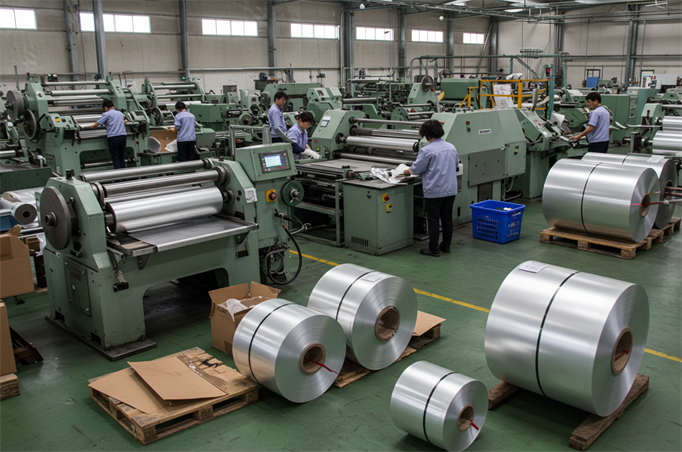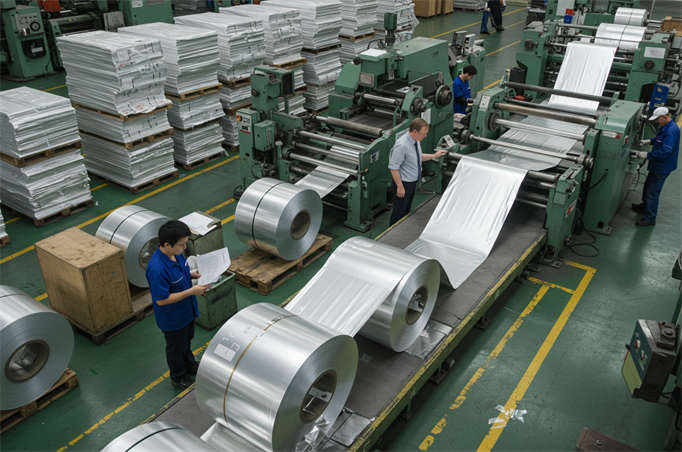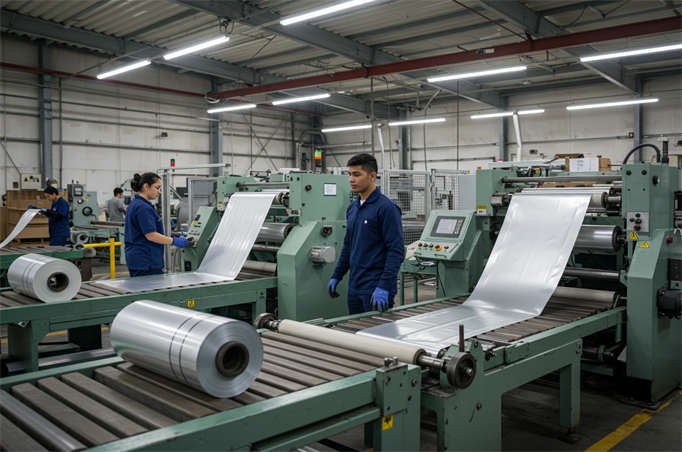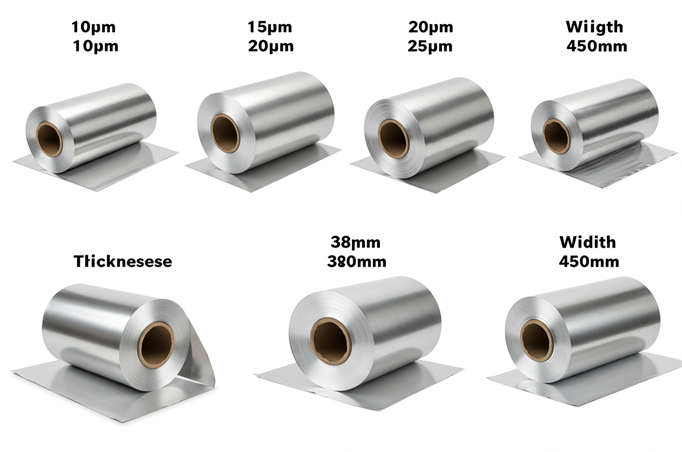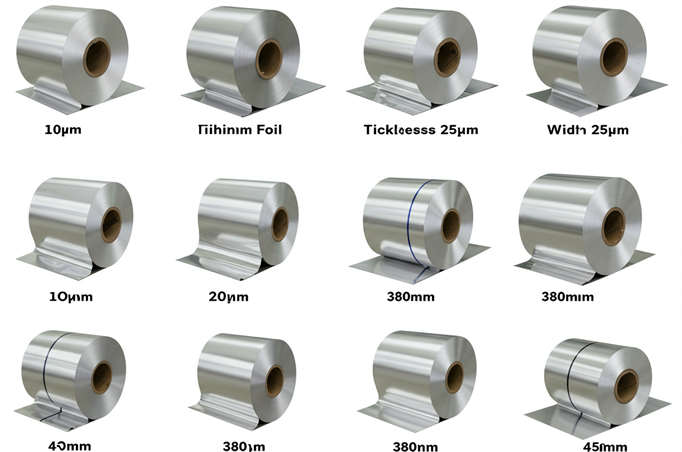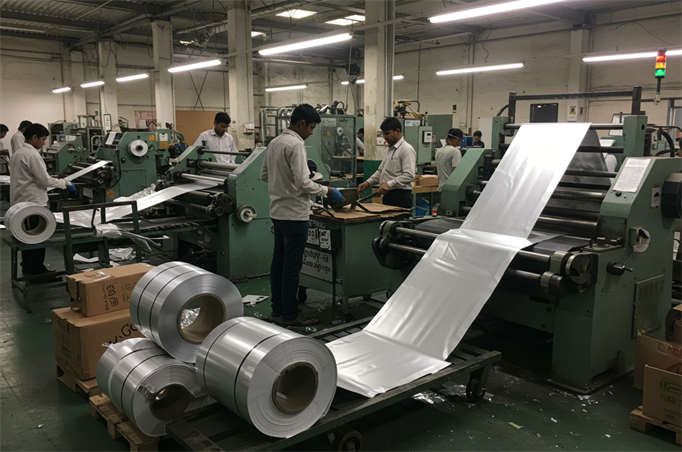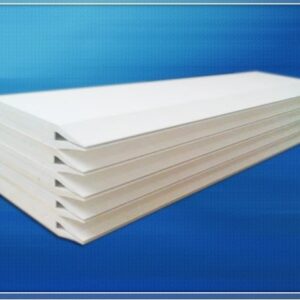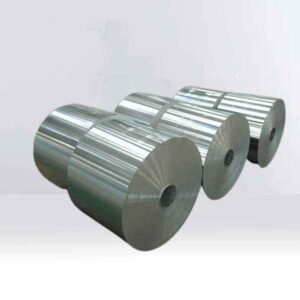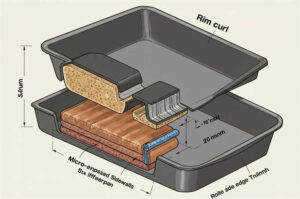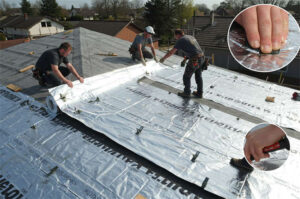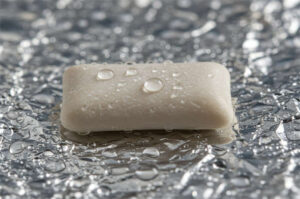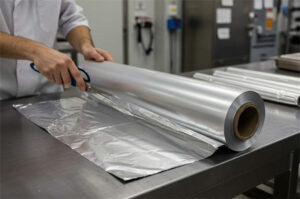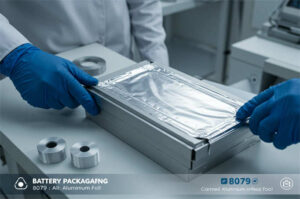Au Feuilles d'aluminium YutwinLe papier d'aluminium est plus qu'un simple matériau, c'est une solution polyvalente qui alimente les industries, protège les produits et améliore la vie de tous les jours. En tant que fournisseur mondial de confiance de feuilles d'aluminium de haute qualité, nous sommes fiers de fournir des matériaux qui répondent aux spécifications les plus exigeantes tout en dépassant les attentes des clients. Que vous travailliez dans l'emballage alimentaire, la construction, l'électronique ou les produits pharmaceutiques, le bon matériau de feuille d'aluminium peut faire toute la différence.
Feuille d'aluminium est célébré pour sa combinaison unique de légèreté, d'excellente conductivité thermique et électrique et de propriétés barrières supérieures. Mais ce qui distingue vraiment la feuille d'aluminium, c'est son adaptabilité. Des alliages de haute pureté de la série 1xxx aux alliages avancés des séries 3xxx, 5xxx et 8xxx, le matériau de la feuille d'aluminium a un impact direct sur les performances, la durabilité et l'adéquation de l'application. Chez Yutwin Aluminum Foil, nous comprenons que la feuille parfaite n'est pas seulement une question de composition d'alliage - il s'agit d'équilibrer la solidité, la flexibilité, la résistance à la corrosion et la conductivité pour répondre à vos besoins spécifiques.
Nos matériaux sont conçus d'exceller dans des environnements divers. Feuilles d'aluminium de haute pureté (série 1xxx) offrent une ductilité et une conductivité exceptionnelles, ce qui les rend idéales pour l'emballage alimentaire, l'enroulement des câbles et les applications électriques. Les feuilles en alliage (séries 3xxx, 5xxx et 8xxx) offrent une résistance mécanique et une résistance à la corrosion accrues, ce qui les rend idéales pour des applications exigeantes telles que la construction, les appareils électroménagers et les composants industriels. Au-delà du choix de l'alliage, l'état du matériau - du recuit doux (état O) au laminage dur (état H19) - permet d'adapter encore davantage les performances. Les feuilles souples offrent une flexibilité inégalée pour le formage complexe, tandis que les feuilles plus rigides assurent la rigidité des applications structurelles.
Chez Yutwin Aluminum Foil, nous ne nous contentons pas de fournir des feuilles d'aluminium, nous nous associons à vous pour trouver la solution matérielle optimale. Notre expertise en science des matériaux garantit que chaque feuille que nous produisons répond à vos besoins, qu'il s'agisse de feuilles ultrafines pour les applications de batteries ou de feuilles robustes pour les conceptions architecturales. Avec des dimensions personnalisables, allant d'une épaisseur de 0,006 mm à une largeur de 2650 mm, nous répondons à des applications allant de l'emballage pharmaceutique délicat à des utilisations industrielles lourdes.
Mais notre engagement ne s'arrête pas là à la matière même. Nous savons que la qualité de la surface est essentielle. Nous proposons des traitements de dégraissage avancés pour garantir que nos feuilles sont exemptes de contaminants, offrant ainsi une surface impeccable pour les processus en aval tels que le laminage, l'impression ou l'enduction. Que vous créiez des films composites avec du PET, du PE ou du papier ou que vous conceviez des solutions autonomes, nos feuilles d'aluminium sont conçus pour s'intégrer de manière transparente dans votre flux de travail.
Dans le monde d'aujourd'hui, qui évolue rapidement, la fiabilité et l'innovation vont de pair. Yutwin Aluminum Foil est à la pointe de la technologie des matériaux, combinant des décennies d'expérience industrielle avec une recherche de pointe pour fournir des matériaux en feuilles d'aluminium qui fonctionnent sous pression. Nous travaillons en étroite collaboration avec vous, de la conception à la livraison, pour assurer la réussite de votre projet.
La feuille d'aluminium est disponible dans différents alliages.
Il existe plusieurs alliages de feuilles d'aluminium, chacun ayant des propriétés différentes. Vous trouverez ci-dessous quelques alliages d'aluminium courants et leurs caractéristiques :
| Série alliage | Notes communes | Principaux éléments d'alliage | Caractéristiques | Champs d'application |
|---|---|---|---|---|
| Série 1xxx | 1050, 1060, 1070, 1100 | Teneur en aluminium ≥99.00% | Conductivité électrique élevée, bonne formabilité, résistance à la corrosion, faible résistance mécanique, non traitable thermiquement | Feuilles pour condensateurs électrolytiques, conteneurs pour produits chimiques, emballage de câbles, emballage alimentaire, etc. |
| Série 3xxx | 3003, 3004 | Manganèse | Bonne résistance à la corrosion et bonne aptitude au formage | Emballages alimentaires, ustensiles de cuisine, etc. |
| Série 5xxx | 5052 | Magnésium | Bonne résistance à la corrosion et solidité | Construction, automobile, appareils ménagers, etc. |
| Série 6xxx | 6061, 6063 | Magnésium et silicium | Bonne formabilité et résistance à la corrosion, traitement thermique | Construction, automobile, appareils ménagers, etc. |
| Série 7xxx | 7075 | Zinc, magnésium, cuivre | Haute résistance, bonne résistance à la corrosion | Aérospatiale, aviation, automobile, etc. |
| Série 8xxx | 8011, 8021, 8079 | Autres éléments | Excellentes propriétés de barrière et de résistance à l'oxydation | Emballages alimentaires, emballages pharmaceutiques, emballages électroniques et électriques, etc. |
Le choix de l'alliage de la feuille d'aluminium dépend des exigences spécifiques de l'application, telles que la solidité, la résistance à la corrosion et la conductivité électrique. Différentes séries d'alliages sont largement utilisées dans diverses industries.
Caractéristiques des alliages et des matériaux de la feuille d'aluminium
Les caractéristiques de la feuille d'aluminium dépendent non seulement de la composition de l'alliage, mais aussi de l'état du matériau. Vous trouverez ci-dessous une ventilation de la composition de l'alliage, de l'état du matériau et des applications de performance :
1. Impact de la composition de l'alliage sur les performances de la feuille d'aluminium
La composition de l'alliage de la feuille d'aluminium détermine ses propriétés chimiques et physiques de base :
(1) La force
- Feuille d'aluminium de haute pureté (série 1xxx) : Il présente une faible résistance et est idéal pour les applications nécessitant une ductilité et une flexibilité élevées, telles que l'emballage alimentaire et le recouvrement de câbles.
- Feuilles d'alliage d'aluminium (par exemple, séries 3xxxx, 5xxx, 8xxx) : L'ajout d'alliages tels que le manganèse et le magnésium augmente la résistance, ce qui permet de l'utiliser dans des applications exigeant un certain niveau de résistance à la rupture, comme les matériaux de construction et les boîtiers d'appareils électroménagers.
(2) Résistance à la corrosion
- Feuille d'aluminium de haute pureté : Expositions bonnes résistance à la corrosion mais il est sensible à des environnements chimiques spécifiques, tels que les conditions acides ou alcalines.
- Feuille d'aluminium en alliage : L'ajout d'alliages tels que le magnésium et le silicium améliore sa résistance à la corrosion, ce qui le rend adapté à des applications plus complexes.
(3) Conductivité électrique
- Feuille d'aluminium de haute pureté : Il offre une excellente conductivité et est couramment utilisé dans les condensateurs électrolytiques et les câbles.
- Feuille d'aluminium en alliage : L'ajout d'éléments d'alliage réduit légèrement sa conductivité, mais il répond aux besoins de la plupart des projets.
(4) Formabilité
- Feuille d'aluminium de haute pureté : Il présente une excellente ductilité, ce qui le rend adapté aux applications nécessitant des formes complexes.
- Feuille d'aluminium en alliage : L'ajout d'éléments d'alliage peut réduire légèrement la formabilité, mais elle reste conforme à la plupart des normes industrielles.
2. Impact de l'état du matériau sur les performances de la feuille d'aluminium
L'état du matériau de la feuille d'aluminium (recuit, mi-dur ou dur) influence considérablement ses propriétés mécaniques et ses caractéristiques d'application :
(1) État recuit (état O)
- Caractéristiques : Obtenu par un traitement de recuit completLa feuille d'aluminium est dans son état le plus mou, offrant une excellente ductilité et une faible résistance.
- Applications : Idéal pour l'emballage alimentaire, l'emballage pharmaceutique et le recouvrement de câbles, où une grande flexibilité est nécessaire.
(2) État demi-dur (H14, H16, H18)
- Caractéristiques : Partiellement travaillé à froid pour obtenir un équilibre entre résistance et ductilité.
- Applications : Convient aux applications nécessitant une résistance modérée tout en conservant une bonne formabilité, telles que les boîtiers d'appareils électroménagers et les décorations de bâtiments.
(3) État dur (H19)
- Caractéristiques : Entièrement travaillé à froid sans recuit, ce qui donne une résistance élevée mais une ductilité minimale.
- Applications : Idéal pour les applications nécessitant une résistance à l'usure et une rigidité élevées, telles que les feuilles de batteries et les composants électroniques.
3. Effet combiné de la composition de l'alliage et de l'état du matériau
Les performances de la feuille d'aluminium résultent de l'effet combiné de la composition de l'alliage et de l'état du matériau. Par exemple :
- Feuille d'aluminium de haute pureté (série 1xxx) à l'état recuit présente une excellente ductilité, ce qui le rend idéal pour les emballages alimentaires. À l'état complexe, il convient aux feuilles de batterie et à d'autres applications à forte usure.
- Feuille d'alliage d'aluminium (par exemple, série 8xxx) à l'état recuit offre de bonnes caractéristiques de protection, ce qui le rend idéal pour les emballages pharmaceutiques. À l'état mi-dur, il convient parfaitement aux applications industrielles nécessitant une résistance modérée.
4. Résumé des principales applications
- Emballage alimentaire : Il utilise généralement des feuilles d'aluminium de haute pureté (par exemple 10600, 8011) à l'état recuit ou mi-dur.
- Feuilles de batterie : On utilise généralement des feuilles d'aluminium de haute pureté (par exemple, 1060, 1070) à l'état complexe.
- Bâtiment et appareils ménagers : Les feuilles d'aluminium en alliage (par exemple 3003, 5052) sont généralement utilisées à l'état mi-dur ou dur.
- Couverture du câble : On utilise généralement des feuilles d'aluminium de haute pureté (par exemple, 1050) à l'état recuit (1060).
Transformation du matériau de la feuille d'aluminium de mou à dur
Lorsque la feuille d'aluminium subit un traitement qui la fait passer de souple à dure et est dégraisséeEn conséquence, ses performances et ses possibilités d'application changent de manière significative. Vous trouverez ci-dessous une explication détaillée de la manière dont la feuille d'aluminium passe de souple à dure et de l'importance du traitement de dégraissage :
Changements dans Matériau de la feuille d'aluminium Condition
- État recuit (état O) : Après un traitement de recuit complet, la feuille est la plus souple possible, offrant une ductilité et une flexibilité excellentes.
- État demi-dur (H14, H16, H18) : La feuille est partiellement travaillée à froid pour équilibrer la résistance et la ductilité.
- État complexe (H19) : Entièrement façonné à froid sans recuit, il présente une résistance élevée et une ductilité minimale.
Traitement de dégraissage
Le dégraissage permet d'éliminer les huiles, les poussières et autres impuretés de la surface de la feuille, ce qui améliore sa qualité et la prépare à un traitement ultérieur. Le processus implique généralement un trempage dans une solution alcaline, suivi d'un nettoyage et d'un séchage afin d'éviter que la solution alcaline ne reste sur la surface et ne provoque une corrosion à long terme.
Spécifications des matériaux des feuilles et rouleaux d'aluminium
Voici les spécifications standard des feuilles et rouleaux d'aluminium et leurs applications :
- Feuille d'aluminium Épaisseur : 0,006 mm à 0,2 mm.
- Largeur : De 100 mm à 2650 mm.
- Longueur : Généralement représenté par un C, indiquant la forme d'un rouleau.
- Rouleau d'aluminium Épaisseur : 0,2 mm à 8 mm.
- Largeur : De 100 mm à 2650 mm.
- Longueur : Généralement représenté par un C, indiquant la forme d'un rouleau.
Exigences en matière d'application et de dimensions
- Emballage alimentaire : L'épaisseur des feuilles d'aluminium varie généralement de 0,006 mm à 0,012 mm, avec des largeurs et des longueurs personnalisées en fonction des exigences de l'emballage.
- Décorations de bâtiments : Les rouleaux d'aluminium ont généralement une largeur comprise entre 1 000 et 2 000 mm et une épaisseur de 0,2 à 1,5 mm.
- Industrie automobile : Les rouleaux d'aluminium ont généralement une largeur comprise entre 1 000 et 2 000 mm et une épaisseur de 0,5 à 2,0 mm.
- Électronique et appareils électriques : L'épaisseur de la feuille d'aluminium varie de 0,01 mm à 0,2 mm, et des largeurs et longueurs personnalisées sont disponibles en fonction des besoins spécifiques.
- Emballage pharmaceutique : Épaisseur de la feuille d'aluminium varie généralement de 0,006 mm à 0,015 mm, avec des largeurs et des longueurs personnalisées en fonction des exigences de l'emballage.
Aluminium et PET, PE, films composites, papier et autres matériaux
La feuille d'aluminium, associée à des matériaux tels que le PET, le PE, les films composites et le papier, offre d'excellentes performances et de nombreuses applications. Voici une description détaillée :
Sacs composites en aluminium et PET
- Film PET revêtu d'aluminium :
- Caractéristiques : Fabriqué par métallisation sous vide, ce film offre une finition métallique brillante, d'excellentes propriétés de barrière aux gaz et à la lumière, une forte résistance à l'humidité et à la chaleur. Il peut remplacer la feuille d'aluminium dans certaines applications.
- Applications : Largement utilisé dans l'emballage alimentaire, l'emballage de tabac haut de gamme, les boîtes cadeaux, le lait en poudre, le thé, les produits pharmaceutiques et les matériaux de sécurité.
- Sacs en composite aluminium-PET :
- Caractéristiques : Fabriqués à partir de deux matériaux différents, combinant les avantages de la feuille d'aluminium et du PET, ces sacs sont légers et mécaniquement solides. Ils offrent d'excellentes propriétés de barrière aux gaz et conviennent résistant à la températureIls sont résistants au vieillissement et faciles à recycler.
- Applications : Largement utilisé dans l'alimentation, les produits pharmaceutiques, les cosmétiques, le blindage électromagnétique, les matériaux de construction et l'électronique.
Sacs composites en aluminium et PE
- Sacs composites en PE :
- Caractéristiques : Structure multicouche combinant un film de polyéthylène (PE) et des adhésifs (par exemple, OP, OPA, OPET, aluminium, papier). Ces sacs offrent flexibilité, résistance à l'humidité, propriétés de barrière à l'oxygène et capacité à bloquer la lumière.
- Applications : Couramment utilisé dans l'emballage des produits alimentaires, des produits de consommation courante et des produits chimiques.
Sacs composites en aluminium et en papier
- Matériau composite aluminium-plastique à base de papier :
- Caractéristiques : Matériau composite composé de papier, de feuille d'aluminium et de plastique. Il offre flexibilité, résistance à l'humidité, propriétés de barrière à l'oxygène et capacité à bloquer la lumière.
- Applications : Il convient aux emballages alimentaires et aux emballages cadeaux haut de gamme. Il permet de contrôler le contenu, de prolonger la durée de conservation et d'améliorer les capacités esthétiques et fonctionnelles de l'emballage.
Ce guide complet vous aide à choisir le matériau de feuille d'aluminium adapté aux besoins de votre application. Les feuilles d'aluminium Yutwin garantissent la plus haute qualité et l'adaptabilité à de nombreux secteurs d'activité.
Chez Yutwin Aluminum Foil, nous sommes motivés par une mission simple : fournir des matériaux en feuilles d'aluminium qui favorisent votre réussite. Notre gamme complète de feuilles, de la série 1xxx de haute pureté aux variantes alliées avancées, garantit une solution adaptée à chaque application. Que vous ayez besoin de la conductivité inégalée des feuilles recuites de haute pureté pour les composants électriques, de la durabilité des feuilles d'alliage laminées pour la construction ou de la précision des feuilles ultra-minces pour les batteries, nous avons ce qu'il vous faut.
Mais nous ne nous contentons pas de fournir des matériaux. Nous savons que le choix de la bonne feuille d'aluminium ne se limite pas à la composition de l'alliage - il s'agit de comprendre comment la trempe du matériau, les dimensions et le traitement de surface influent sur les performances. Nos feuilles recuites (trempe O) offrent une flexibilité inégalée pour l'emballage et le formage, tandis que nos feuilles semi-dures (H14-H18) et laminées dures (H19) offrent la résistance nécessaire pour les applications structurelles. Avec des épaisseurs, des largeurs et des longueurs personnalisables, nous veillons à ce que votre feuille s'intègre parfaitement dans votre processus de production, que vous travailliez dans l'emballage alimentaire, l'électronique ou la fabrication automobile.
La qualité est au cœur de toutes nos activités. Nos processus de dégraissage rigoureux garantissent que chaque feuille que nous produisons est exempte de contaminants, ce qui assure une adhérence optimale du laminage, de l'impression ou de l'enduction. Ce souci du détail s'étend à nos solutions composites, où la feuille d'aluminium se combine avec du PET, du PE ou du papier pour créer des matériaux qui équilibrent les propriétés de barrière, la flexibilité et l'esthétique. Qu'il s'agisse d'emballages alimentaires ou pharmaceutiques, de blindage électromagnétique ou d'applications décoratives, nos composites offrent des performances sans compromis.
Nous sommes fiers d'être plus qu'un simple fournisseur - nous sommes un partenaire de votre succès. Notre équipe d'experts en matériaux travaille en étroite collaboration avec vous pour comprendre vos défis uniques et fournir des solutions qui dépassent les attentes. Qu'il s'agisse de lancer un nouveau produit, d'optimiser un processus existant ou d'explorer des applications innovantes, Yutwin Aluminum Foil vous soutient à chaque étape.
Dans un secteur où la précision est essentielle, faites confiance à Yutwin Aluminum Foil pour vous fournir des matériaux performants. Notre engagement en faveur de l'innovation, de la qualité et de la collaboration avec nos clients garantit que vos besoins en matière de feuilles d'aluminium sont satisfaits et dépassés. Prêt à élever votre projet ? Contactez-nous dès aujourd'hui pour découvrir comment Yutwin Aluminum Foil peut transformer votre vision en réalité.

